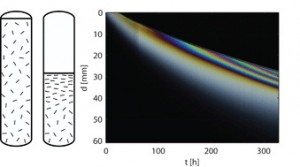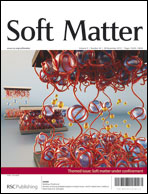 Reconfigurable soft matter systems are distinguished by their remarkable ability to sense and respond to external stimuli or changes in the environment by readjusting their morphology and/or functionality. Published last week, the Soft Matter themed issue on Reconfigurable Soft Matter highlights the new advances in designing and creating such materials. Guest Editors Anna Balazs and Joanna Aizenberg introduce the issue in their Editorial.
Reconfigurable soft matter systems are distinguished by their remarkable ability to sense and respond to external stimuli or changes in the environment by readjusting their morphology and/or functionality. Published last week, the Soft Matter themed issue on Reconfigurable Soft Matter highlights the new advances in designing and creating such materials. Guest Editors Anna Balazs and Joanna Aizenberg introduce the issue in their Editorial.
Here is a small sample of the excellent review, communication and full articles contained within the themed issue:
-
Autonomic composite hydrogels by reactive printing: materials and oscillatory response R. C. Kramb, P. R. Buskohl, C. Slone, M. L. Smith and R. A. Vaia
- Reconfigurable and actuating structures from soft materials Ren Geryak and Vladimir V. Tsukruk
- Bioinspired materials that self-shape through programmed microstructures André R. Studart and Randall M. Erb (Open access)
- Self-replication in colloids with asymmetric interactions Rui Zhang, Joshua M. Dempster and Monica Olvera de la Cruz
- Reconfigurable assemblies of Janus rods in AC electric fields Kundan Chaudhary, Jaime J. Juárez, Qian Chen, Steve Granick and Jennifer A. Lewis
- Electro-actuated hydrogel walkers with dual responsive legs Daniel Morales, Etienne Palleau, Michael D. Dickey and Orlin D. Velev
- Microgel film dynamics modulate cell adhesion behavior Shalini Saxena, Mark W. Spears Jr, Hiroaki Yoshida, Jeffrey C. Gaulding, Andrés J. García and L. Andrew Lyon
- Modeling polymer grafted nanoparticle networks reinforced by high-strength chains Matthew J. Hamer, Balaji V. S. Iyer, Victor V. Yashin, Tomasz Kowalewski, Krzysztof Matyjaszewski and Anna C. Balazs
- Autonomous viscosity oscillation via metallo-supramolecular terpyridine chemistry of branched poly(ethylene glycol) driven by the Belousov–Zhabotinsky reaction Takeshi Ueki, Yumi Takasaki, Kaori Bundo, Tomonaga Ueno, Takamasa Sakai, Yuki Akagi and Ryo Yoshida





























